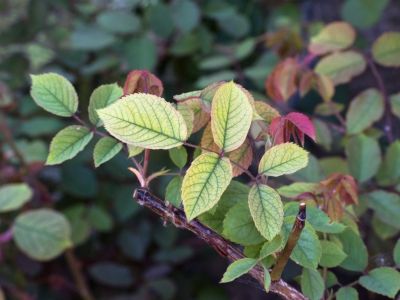About Rose Plant Iron Deficiencies
What does iron do for the overall rose bush you may ask? Iron aids in chlorophyll formation and activates other enzymes, which help activate nitrogen used by the bush. In other words, iron helps promote that nice dark green foliage that is one of the signs of happy, healthy rose bushes or other plants in our gardens. It is rare that iron is actually deficient in the soil; more often it is something about the soil’s makeup that is locking up the iron and not allowing it to be readily available to the plant. Some things that can lock up the availability of iron are:
High pH Low pH Poor aeration (drainage) High soluble salts in the soil High concentrations of zinc, phosphorous, or manganese in the soil
Iron Deficiency Symptoms in Roses
Iron deficiency is often confused with oxygen deficiency; however, the symptoms of these deficiencies are actually the opposite of one another. Let’s take a look at both so you will be able to recognize them and readily tell the difference. With iron deficiency, the leaves show you there is a problem. The main structure of the leaves turns yellow while the main veins of the leaves remain green. The yellowing of the leaves is known as chlorosis. With oxygen deficiency, the leaves will also show us there is a problem. However, with oxygen deficient plants, the main veins of the leaves turn yellow or show the signs of chlorosis first, then the yellowing will spread to the main leaf structure. Oxygen deficiency is basically the lack of air to the root system, which occurs with overwatering or poor soil drainage. It is important to be able to recognize the difference so that proper treatment action can be taken. Oxygen deficiency can usually be corrected by monitoring watering of our gardens better, aerating the soil, or taking steps to improve the overall soil drainage.
Solving Rose Iron Deficiencies
Truly treating an iron deficiency in roses can be a complex task but is worth taking time to ensure a long-lasting solution to the problem. Some temporary relief can be achieved by the foliar or spray application of chelated iron or other nutrient sprays that contain a good amount of iron. Such temporary measures are helpful while we work out the long-lasting solution. To truly correct the problem, however, we need to dig a bit deeper, such as checking the pH in the soil and seeing if there are issues that are causing a locking up of nutrients available in the soil. Having the garden soil tested to get a report on the available nutrients is a good idea. Such a test lets us know where the soil’s nutrient capacity stands. Usually, the testing lab can and will give input as to ways to correct any soil nutrient issues. We have a tendency, when noticing problems in our gardens, to jump to an immediate form of treatment. Such treatment may help some or it can make things worse. Once the soil is tested and we know there is a problem with iron, we can add iron amendments such as Greensand, a good, cured garden ready manure, cottonseed meal, or ready-to-use iron amendment products. The soil testing may well show other imbalances that are actually causing the problems; thus, we can spend our hard-earned money actually doing what is required, rather than trying many things that only provide temporary relief or worsening of the problem.
